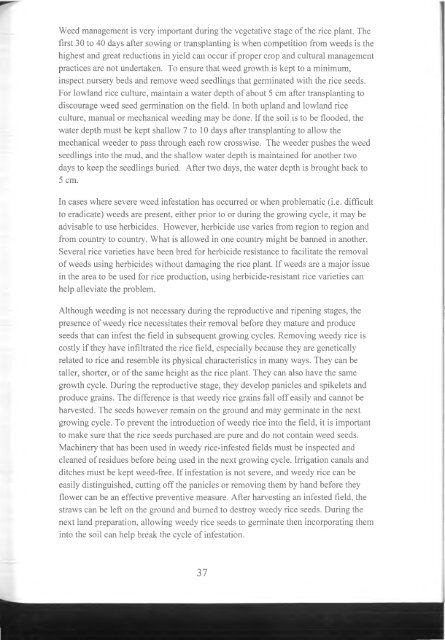Bradbrook - 2012 - Rice Farming complete with methods to increase ric
Bradbrook - 2012 - Rice Farming complete with methods to increase ric
Bradbrook - 2012 - Rice Farming complete with methods to increase ric
Create successful ePaper yourself
Turn your PDF publications into a flip-book with our unique Google optimized e-Paper software.
Weed management is very important during the vegetative stage of the <strong>ric</strong>e plant. The<br />
first 30 <strong>to</strong> 40 days after sowing or transplanting is when competition from weeds is the<br />
highest and great reductions in yield can occur if proper crop and cultural management<br />
practices are not undertaken. To ensure that weed growth is kept <strong>to</strong> a minimum,<br />
inspect nursery beds and remove weed seedlings that germinated <strong>with</strong> the <strong>ric</strong>e seeds.<br />
For lowland <strong>ric</strong>e culture, maintain a water depth of about 5 cm after transplanting <strong>to</strong><br />
discourage weed seed germination on the field. In both upland and lowland <strong>ric</strong>e<br />
culture, manual or mechanical weeding may be done. If the soil is <strong>to</strong> be flooded, the<br />
water depth must be kept shallow 7 <strong>to</strong> 10 days after transplanting <strong>to</strong> allow the<br />
mechanical weeder <strong>to</strong> pass through each row crosswise. The weeder pushes the weed<br />
seedlings in<strong>to</strong> the mud, and the shallow water depth is maintained for another two<br />
days <strong>to</strong> keep the seedlings buried. After two days, the water depth is brought back <strong>to</strong><br />
5 cm.<br />
In cases where severe weed infestation has occurred or when problematic (i.e. difficult<br />
<strong>to</strong> eradicate) weeds are present, either prior <strong>to</strong> or during the growing cycle, it may be<br />
advisable <strong>to</strong> use herbicides. However, herbicide use varies from region <strong>to</strong> region and<br />
from country <strong>to</strong> country. What is allowed in one country might be banned in another.<br />
Several <strong>ric</strong>e varieties have been bred for herbicide resistance <strong>to</strong> facilitate the removal<br />
of weeds using herbicides <strong>with</strong>out damaging the <strong>ric</strong>e plant. If weeds are a major issue<br />
in the area <strong>to</strong> be used for <strong>ric</strong>e production, using herbicide-resistant <strong>ric</strong>e varieties can<br />
help alleviate the problem.<br />
Although weeding is not necessary during the reproductive and ripening stages, the<br />
presence of weedy <strong>ric</strong>e necessitates their removal before they mature and produce<br />
seeds that can infest the field in subsequent growing cycles. Removing weedy <strong>ric</strong>e is<br />
costly if they have infiltrated the <strong>ric</strong>e field, especially because they are genetically<br />
related <strong>to</strong> <strong>ric</strong>e and resemble its physical characteristics in many ways. They can be<br />
taller, shorter, or of the same height as the <strong>ric</strong>e plant. They can also have the same<br />
growth cycle. During the reproductive stage, they develop panicles and spikelets and<br />
produce grains. The difference is that weedy <strong>ric</strong>e grains fall off easily and cannot be<br />
harvested. The seeds however remain on the ground and may germinate in the next<br />
growing cycle. To prevent the introduction of weedy <strong>ric</strong>e in<strong>to</strong> the field, it is important<br />
<strong>to</strong> make sure that the <strong>ric</strong>e seeds purchased are pure and do not contain weed seeds.<br />
Machinery that has been used in weedy <strong>ric</strong>e-infested fields must be inspected and<br />
cleaned of residues before being used in the next growing cycle. Irrigation canals and<br />
ditches must be kept weed-free. If infestation is not severe, and weedy <strong>ric</strong>e can be<br />
easily distinguished, cutting off the panicles or removing them by hand before they<br />
flower can be an effective preventive measure. After harvesting an infested field, the<br />
straws can be left on the ground and burned <strong>to</strong> destroy weedy <strong>ric</strong>e seeds. During the<br />
next land preparation, allowing weedy <strong>ric</strong>e seeds <strong>to</strong> germinate then incorporating them<br />
in<strong>to</strong> the soil can help break the cycle of infestation.<br />
37

















